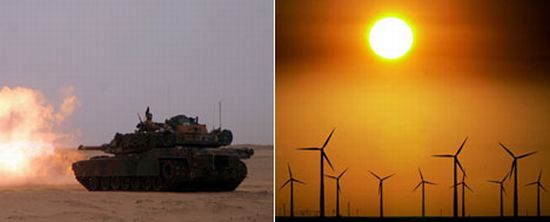
It’s ironic. The U.S. Military wants to cut down on oil usage in the ongoing war. To tackle the budget, they turn into diehard environmentalists and conservationists! However, the military would have us believe that the change in operations stems from genuine concern for the environment. We would definitely like to believe that.
A look at the figures below would make it crytal clear why it suddenly became so necessary to tread the “environment’ path. The Department of Defense is the largest energy consumer in the United States, racking up an energy bill of $13.6 billion last year, up from $10.9 billion the year before. The military services and other components of the defense establishment consume the equivalent of 340,000 barrels of oil a day, or 1.5 percent of total U.S. energy consumption. The solar array could save the Air Force $1 million annually in energy expenses. A 280-megawatt power plant runs on geothermal energy — heat from the ground — at the China Lake Naval Air Weapons Station in California. Four 275-foot-tall wind turbines at Guantanamo Bay have helped save an estimated $1.2 million a year that otherwise would have been spent on fossil fuel.
On December 17th, the Air Force will dedicate the largest solar array in North America at Nevada’s Nellis Air Force Base, on the same day that a C-17 transport plane makes the Air Force’s first cross-country flight using a blend of synthetic fuel. Giant wind turbines rise from the U.S. Naval Base at Guantanamo Bay, Cuba. Army leaders are embracing hybrid vehicles, fuel cells and other emerging technologies. All the services are enforcing new building standards at their installations to include more durable material, more efficient heating and cooling systems and other energy-oriented measures. Solar panels often are placed on the roofs of carports.
Moreover, not ceasing to surprise the world, the military services have rescued endangered animals that make their homes on training bases or bombing ranges, repopulating some bird species like the snowy plover and the California least tern. Also, soldiers, sailors, airmen and Marines turn off the lights in the barracks to exotic research into future technology. Military researchers are looking into new designs for ships, aircraft, land vehicles and propulsion systems with an eye toward cutting energy costs. ‘In essence, the Army is building green, buying green and going green,’ said Tad Davis, the Army’s deputy assistant secretary for environment, safety and occupational health.
The future might hold even more pleasant surprises coming from the U.S. Military. It hopes to certify the service’s entire fleet for the synfuel blend by 2011. The Air Force also is looking into the feasibility of equipping a base with a small nuclear power plant. Army officials are looking into next-generation hybrid vehicles and alternative power sources on the battlefield — possibly wind or solar — to reduce the need for conventional fuel. An important side benefit in war zones would be lessening the dependency on fuel-truck convoys, which face the threat of ambushes or roadside bombs.
Donald R. Schregardus, the deputy assistant secretary of the Navy who oversees environmental programs, said We have a tremendous resource in the men and women of the armed services who have grown up with the environmental ethic. It’s the right thing to do. We’re trying to be true stewards of the environment.
Via: Core77




